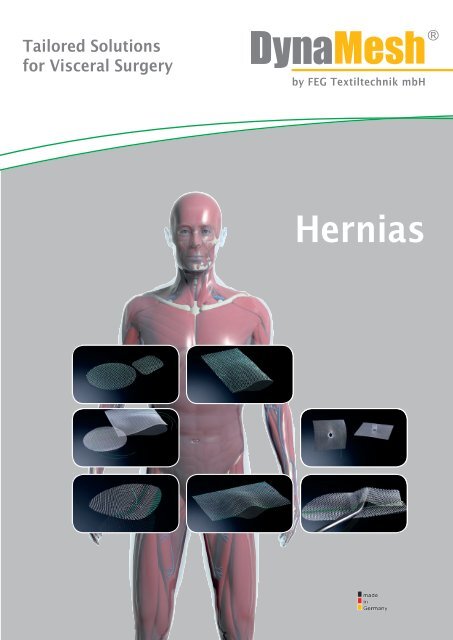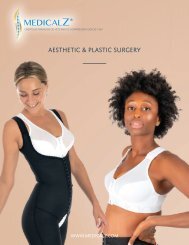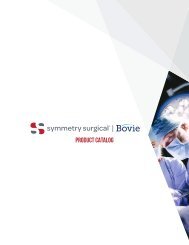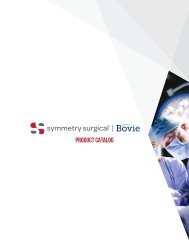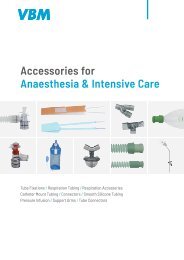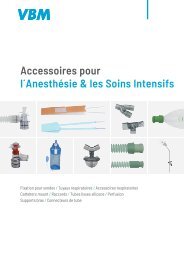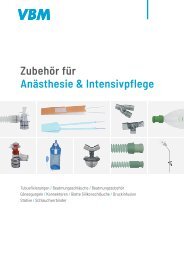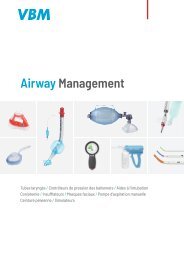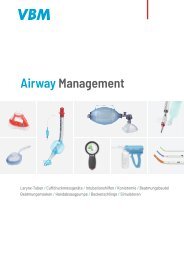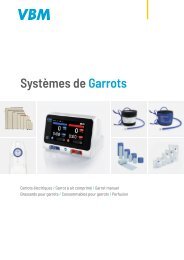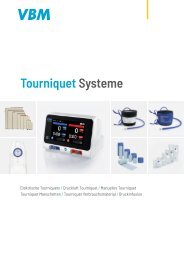Create successful ePaper yourself
Turn your PDF publications into a flip-book with our unique Google optimized e-Paper software.
Tailored Solutions<br />
for Visceral Surgery<br />
by FEG Textiltechnik mbH<br />
<strong>Hernias</strong>
Tailored Solutions for Visceral Surgery<br />
Some of our products may not be available in your<br />
country. Please contact your local distributor for<br />
more information.<br />
Legal information<br />
© FEG Textiltechnik mbH Aachen, Germany<br />
Design: high standArt, Osnabrück - hsam.de<br />
Photography: Schubert Fotografie, Ladbergen<br />
Computer images: Jean Philipp Ihle, Leipzig; IOVIS GmbH, Aachen<br />
Text: FEG + Peter Karl Müller, Münster<br />
Translation: mpü medpharm medtec biotec translations, Ulm<br />
Printed by: Druckerei Meyer, Osnabrück<br />
Date of publication: 01/04/2016<br />
2
Expert Technologies in PVDF<br />
It all begins with a thread<br />
In the beginning, there was not just any thread but a<br />
filament made of PVDF*: tear-resistant, biocompatible and<br />
smooth. PVDF “naturally” supplies many of the properties<br />
characteristic of an ideal implant. However, the thread first has to be warp-knitted<br />
into a textile structure. Not just anyhow but tailor-made for the relevant indication.<br />
The right stitch makes the difference. Only through the right stitch can we achieve the<br />
“inner values” required, such as stability, elasticity and porosity. So the end result is<br />
not a “one fits all” implant but a specifically created DynaMesh ® high-tech product.<br />
A product which enables doctors to perform their duties as effectively as possible –<br />
and which gives patients many symptom-free and safe years.<br />
*The polymer PVDF<br />
The starting point for all DynaMesh ® products is a PVDF<br />
monofilament – a synthetic yarn made from polyvinylidene<br />
fluoride. Its diameter is between 0.085 and 0.165 mm. PVDF<br />
is an extremely ageing-resistant, thermoplastic fluoroplastic<br />
with suitably adapted elasticity. It is tear-resistant,<br />
biocompatible and produced with extreme precision. PVDF<br />
has been known to be a superior suture material since 1995;<br />
it has been used successfully in textile implants since 2003<br />
[1,5].<br />
www.dyna-mesh.com 3
Tailored Solutions for Visceral Surgery<br />
Contents<br />
It all begins with a thread 3<br />
Contents 4<br />
Our promise: you can rely on it 5<br />
Our company: “Made in Germany“ high-tech products 7<br />
Our development: a specific solution for every indication 9<br />
DynaMesh ® products:<br />
Excellent properties 11<br />
Superior Textile Engineering 13<br />
Optimal integration 15<br />
DynaMesh ® visible: a better internal view without risk 17<br />
Implants for inguinal hernias<br />
DynaMesh ® -LICHTENSTEIN - Lichtenstein technique 20<br />
DynaMesh ® -ENDOLAP - preperitoneal techniques 22<br />
TEP, TAPP<br />
DynaMesh ® -ENDOLAP 3D - preperitoneal techniques 24<br />
TEP, TAPP<br />
Implants for abdominal wall hernias<br />
DynaMesh ® -IPOM - intraperitoneal 28<br />
Ventral hernia<br />
DynaMesh ® -CICAT - extraperitoneal 30<br />
Hernia prophylaxis<br />
Ventral hernia<br />
Implants for umbilical hernias<br />
DynaMesh ® -IPOM - intraperitoneal 34<br />
DynaMesh ® -CICAT - extraperitoneal 35<br />
Implants for parastomal hernias<br />
DynaMesh ® -IPST - intraperitoneal 38<br />
Prophylaxis of parastomal hernia<br />
Literature 40<br />
4
Our promise<br />
You can rely on it<br />
What matters to you as a doctor<br />
Textile implants that deliver optimal and efficient patient care. Efficient<br />
and uncomplicated handling during surgery. Surgical results that give<br />
doctor and patient lasting satisfaction.<br />
What matters to your patients<br />
Textile implants which are virtually undetectable, which provide freedom<br />
of movement without discomfort or restrictions and whose long-term<br />
functioning can be monitored postoperatively, thanks to visible<br />
technology, without further surgical procedures. Long-term solutions<br />
which mean they can live free of pain and discomfort.<br />
What matters to us as the manufacturer<br />
Textile implants made of a raw material which we understand completely:<br />
PVDF. A production that we have under control from start to finish. Our<br />
products are not only tailor-made for the relevant indications or surgical<br />
techniques but also been developed alongside surgeons for new and<br />
improved surgical procedures.<br />
by FEG Textiltechnik mbH<br />
www.dyna-mesh.com 5
Tailored Solutions for Visceral Surgery<br />
Everything under one label<br />
We, FEG Textiltechnik mbH, have our company head office in<br />
the city of Aachen (North Rhine-Westphalia, Germany).<br />
We are the leading developer of textile implants, which we<br />
manufacture exclusively in Germany. They are distributed<br />
worldwide under the brand name DynaMesh ® .<br />
by FEG Textiltechnik mbH<br />
Everything from a single source<br />
Whether it’s a matter of product development,<br />
manufacture, quality control, dispatch or<br />
advice, we undertake all production steps<br />
ourselves from spinning the filament (yarn) to<br />
final packaging. In this way, we achieve optimal<br />
results at every stage in the process.<br />
Everything under control<br />
When manufacturing our products<br />
we place the utmost importance<br />
on compliance with Medical Device<br />
Directive 93/42/EEC and are certified<br />
according to DIN EN ISO 13485.<br />
Production takes place in clean rooms<br />
certified according to ISO 14644-1 and<br />
graded as class 7 and class C under the<br />
EC GMP Directive.<br />
6
Our company<br />
“Made in Germany“ high-tech products<br />
Everything for the doctor<br />
Our range includes customised textile implants for modern<br />
hernia and stoma surgery. At the same time, we offer special<br />
mesh implants for hernia repair and prophylaxis. Together with<br />
experienced surgeons we organise seminars and workshops.<br />
The latest information: You can find information about workshops at:<br />
http://dyna-mesh.com/events/<br />
by FEG Textiltechnik mbH<br />
Everything for the future<br />
Our high-performance Research and<br />
Development Department is working on<br />
the next generation of products today.<br />
In association with the world’s leading<br />
research facilities and hospitals, our<br />
engineers work with well-known medical<br />
specialists to shape the future.<br />
Everything with distinction<br />
In 2003, we were awarded the Aachen Innovation Prize.<br />
In 2007, our visible technology won an award (“Innovation<br />
competition to promote medical technology” by the Federal<br />
Ministry of Education and Research).<br />
www.dyna-mesh.com 7
Tailored Solutions for Visceral Surgery<br />
Restoring functionality<br />
Implants are designed to replace natural bodily functions that have been lost<br />
and in doing so to restore balance to destroyed physiology.<br />
Stability<br />
Elasticity<br />
Optimal<br />
patient safety<br />
Optimal<br />
patient<br />
comfort<br />
Porosity<br />
Understanding the problems<br />
To develop an optimal implant we need to ask ourselves a lot of questions.<br />
For example: In which part of the body will it be implanted? What functions does it<br />
have to fulfil? What static and dynamic stresses act on the implant?<br />
Relevant dynamometric measurements, discussions with surgeons<br />
and the expertise of our engineers provide the answers.<br />
Defining functionality<br />
Together with medical experts our engineers can define the shape, functionality and<br />
profile of properties for the implant. They now know exactly what stabilities, elasticities and<br />
porosities are required, how handling can be improved for the surgeon<br />
and much more.<br />
8
Our development<br />
A specific solution for every indication<br />
Finding individual solutions - avoiding the wrong path<br />
There is no such thing as a single textile structure for all indications – no “allrounder” for all cases (no “one fits all”).<br />
As every indication makes different demands of a textile implant, every indication needs its individual solution<br />
(a tailored approach).<br />
Adapting properties<br />
DynaMesh ® products are not woven or conventionally knitted but warp-knitted*.<br />
This technology, unlike any other, makes it possible to make specific variations<br />
in the shape and structure of a textile implant, which means that we can<br />
construct features with different characteristics in different places within the<br />
structure. More accurate adaptation of implants to the relevant indication is<br />
impossible.<br />
*Warp-knitted fabric.<br />
Warp-knitted fabrics are a type<br />
of knitted fabric. A warp knitting<br />
machine is used for industrial<br />
production of this kind of fabric<br />
(by stitch formation from thread<br />
systems).<br />
www.dyna-mesh.com 9
Tailored Solutions for Visceral Surgery<br />
The filament (“yarn”) we spin from the<br />
high-tech polymer PVDF is the first guarantee of the high quality<br />
of DynaMesh ® products: a filament with many positive “natural” properties.<br />
The textile structures warp-knitted from this are the second guarantee.<br />
Very high body compatibility<br />
PVDF filaments have excellent biocompatibility and reduce adverse foreign body reactions, such as scar<br />
contractions or pain. In addition, they are finer and smoother than conventional filaments. So PVDF is associated<br />
with substantially lower granuloma formation (scar tissue) compared with conventional polymers [2,3,4].<br />
A comparison of different granuloma<br />
thicknesses (cross-sectional view)<br />
PVDF<br />
PP<br />
Natural<br />
tissue<br />
Foreign body<br />
granuloma<br />
=<br />
Scar capsule<br />
+<br />
Inflammatory<br />
cell infiltrate<br />
PVDF<br />
Implant<br />
surface<br />
PP<br />
300 %<br />
250 %<br />
200 %<br />
150 %<br />
100 %<br />
50 %<br />
100 % PVDF<br />
100 % PP (polypropylene)<br />
50 % PP + 50 %<br />
absorbable component<br />
Reduced bacterial adherence<br />
Scientific studies* from Aachen University (RWTH) Hospital<br />
demonstrate that lower quantities of bacteria adhere to textile<br />
implants made from pure PVDF (reduced bacterial adherence).<br />
This is a significant finding for all open techniques because<br />
the risk of infection drops substantially with lower bacterial<br />
adherence.<br />
0 %<br />
S. aureus S. epidermidis<br />
E. coli genta<br />
sensitive<br />
10<br />
* Klosterhalfen, B., Pathologisches Institut, Krankenhaus Düren and Klinge, U., Universitätsklinikum Aachen «Vergleich von Bakterienadhärenzen» (2010)<br />
A comparison of 100% PVDF (polyvinylidene fluoride) with 100% PP (polypropylene) and 50% PP + 50% absorbable component. In this study, cultures of<br />
reference strains of relevant bacteria were applied to different meshes. A subsequent fluorescence measurement clearly showed that the smallest<br />
quantity of bacteria had colonised meshes made from pure PVDF.
DynaMesh ® products<br />
Excellent properties<br />
High ageing resistance<br />
It is not just experience that shows that PVDF<br />
provides lasting success in many surgical<br />
disciplines. A long-term study over seven<br />
years has demonstrated that the condition of<br />
the PVDF surface remains unchanged. Thread<br />
and warp-knitted fabric remain stable and<br />
nothing becomes brittle [2].<br />
A long-term trial (7 years):<br />
• PVDF loses only 7.5% tensile strength<br />
• PP loses 46.6% tensile strength<br />
and stiffens<br />
With the kind permission of:<br />
Laroche G, Marois Y, Schwarz E, Guigoin R, King M W, Pâris E, Douville Y:<br />
Polyvinylidene Fluoride Monofilament Sutures:<br />
Can They Be Used Safely for Long-Term Anastomoses in the Thoracic Aorta?<br />
Artificial Organs 19/11: 1190-1199; ©Blackwell Science, Inc., Boston (12/1995)<br />
www.dyna-mesh.com 11
Tailored Solutions for Visceral Surgery<br />
Minimally reactive surface<br />
If you want to minimise adverse foreign body reactions and scarring associated with textile implants,<br />
besides using biocompatible material you have to provide the least possible contact area. The following formula applies:<br />
thread surface = bioreactive surface area of the implant. Our implants have a comparatively minimal reactive<br />
surface area, which means that they cause the least possible foreign body reaction and scar tissue formation.<br />
Comparison conventional closed DynaMesh ® -<br />
small-pore membrane LICHTENSTEIN<br />
mesh implant<br />
Implant/Size<br />
15 x 15 cm 15 x 15 cm 15 x 15 cm<br />
plant surface area 225 cm² 225 cm² 225 cm²<br />
Reactive surface area of the<br />
implant (thread surface) 637 cm² 450 cm² 288 cm²<br />
reactive surface area/<br />
implant surface area (factor) 2.83 cm²/cm² 2.00 cm²/cm² 1.28 cm²/cm²<br />
Change in the reactive<br />
surface area compared to + 42 % 0% - 36 %<br />
closed membrane<br />
Atraumatic selvedges<br />
DynaMesh ® products are not simply cut from a flat piece of mesh. Using our special warp knitting machines we are able to<br />
produce smooth and therefore atraumatic selvedges (no “sawtooth” edges).<br />
These “soft” selvedges make it easy for the surgeon<br />
to place and adjust the implant – without irritating<br />
or even damaging the surrounding tissue. And the<br />
patient receives an implant with selvedges which will<br />
not “pinch” or cause other injury later on.<br />
Conventional mesh<br />
DynaMesh ® -LICHTENSTEIN<br />
12
DynaMesh® products<br />
Superior Textile Engineering<br />
Optimal dynamometry<br />
Textile implants must reinforce tissue, support muscles and protect organs.<br />
They have to cushion different forces without limiting mobility – including<br />
the extreme stresses associated with coughing, sneezing and laughing.<br />
What is needed therefore is an optimal interaction between predefined<br />
stability and elasticity. We achieve the optimal balance between these<br />
two properties.<br />
The behaviour of abdominal walls with different mesh<br />
implants under stress<br />
with mesh that is too elastic<br />
healthy abdominal wall with no mesh<br />
with optimised DynaMesh®<br />
with mesh that is too stiff<br />
Pressure<br />
Abdominal wall explant<br />
A study of explanted abdominal walls<br />
(source: Aachen University Hospital)<br />
High tear propagation resistance<br />
Conventional textile implants have a weak point:<br />
once torn or cut a zipper effect frequently<br />
occurs – the mesh continues to tear (mesh<br />
rupture). This does not happen with<br />
DynaMesh® products. The multiple meshing<br />
technique used in our warp-knitted structures<br />
does not allow this unwanted effect to occur in<br />
the first place. Tear propagation resistance is<br />
one of the basic properties common to all our<br />
implants.<br />
DynaMesh ®<br />
Conventional mesh<br />
www.dyna-mesh.com 13
Tailored Solutions for Visceral Surgery<br />
Effective porosity<br />
During incorporation the filaments are enclosed by an internal and external granuloma.<br />
When filament distance is too small there is a risk that the whole of the intervening space will be<br />
filled with scar tissue (closed pores). The scar plates that develop in this way cause patients great<br />
discomfort. Sufficiently large pores can prevent this.<br />
Monofilament<br />
Internal granuloma<br />
(cell-rich with giant<br />
foreign body cells)<br />
External granuloma<br />
(collagen-rich connective<br />
tissue capsule = scar)<br />
Thread distance < 1.0 mm<br />
Pores closed by scar tissue<br />
(“bridging”)<br />
14<br />
Textile porosity refers to the<br />
permeable component of a mesh<br />
before the body has reacted to the<br />
implant.
DynaMesh® products<br />
Optimal integration<br />
How is this prevented? PP implants must have a pore diameter of at least 1 mm<br />
in all directions - under loading as well (!) (because of the lower granuloma thickness,<br />
just 0.6 mm is sufficient in the case of PVDF) – for the pores to remain open.<br />
Only in this way can local autochthonous tissue form through a pore [6,8].<br />
DynaMesh ® warp-knitted fabrics provide this prerequisite because of their optimal pore<br />
geometry and the high effective porosity* (up to 69 %) achieved through this geometry .<br />
Pores filled with<br />
local autochthonous<br />
tissue<br />
Thread distance > 1.0 mm,<br />
so the pore remains intact<br />
*Effective porosity refers to the permeable<br />
component of a mesh after the body has<br />
reacted to the implant.<br />
Rule of thumb:<br />
A “pore” less than 1 mm in diameter is closed<br />
by the body with scar tissue<br />
= 0% effective porosity<br />
www.dyna-mesh.com 15
Tailored Solutions for Visceral Surgery<br />
The problem with monitoring<br />
In many indications, the correct positioning of the implant must be checked after<br />
a certain time. But a “look inside” involves risks. Conventional mesh implants<br />
are invisible in diagnostic radiology. Patients sometimes have to undergo a<br />
second-look operation.<br />
A simple alternative<br />
The unique DynaMesh ® visible provides cutting edge technology,<br />
which is extremely safe and effective. To put it simply: we mix<br />
the PVDF filament with ferromagnetic micropigments using an<br />
inhouse procedure. This guarantees optimal incorporation of the<br />
pigments. Long-term tests demonstrate that the micropigments<br />
are integrated into the PVDF polymer – you could say hermetically<br />
sealed.<br />
A clear internal view<br />
DynaMesh ® visible implants can be made visible using magnetic<br />
resonance imaging (MRI) [7] both in standard sequences and in highresolution,<br />
three-dimensional images or even films. As such, radiologists<br />
can reliably and accurately determine the position and condition of the<br />
implant. Additionally, if required, they can observe how the implant behaves<br />
in motion.<br />
Effective healing<br />
Because it is so easy and safe to take a „look inside”, DynaMesh ® visible opens up new<br />
perspectives. Risk-free monitoring of how healing is progressing, optimal monitoring in clinical<br />
studies or more rapid development of pioneering implants – together with world-renowned clinical<br />
partners.<br />
Moreover, DynaMesh ® visible is the world’s first technology to visualise textile implants. It was<br />
given an award by the German Federal Ministry of Education and Research (BMBF 01EZ 0849).<br />
Gained an award<br />
in the innovation competition run by the<br />
16<br />
The development was sponsored by the<br />
German Federal Ministry<br />
of Education and Research<br />
(BMBF 01EZ 0849)
DynaMesh ® visible<br />
A better internal view without risk<br />
3-dimensional remodelling<br />
During MRI scans, in imaging terms the part of the body being analysed is scanned step by step and<br />
deconstructed into many “wafer-thin optical slices”. At the end, these “slices” are reconstructed to form<br />
3-dimensional images or motion sequences (remodelling).<br />
The position of the DynaMesh ® visible implant can be visualised and monitored in detail.<br />
The 3D internal view supplies useful information.<br />
www.dyna-mesh.com 17
Tailored Solutions for Visceral Surgery<br />
Contents<br />
Implants for inguinal hernias<br />
DynaMesh ® -LICHTENSTEIN - Lichtenstein technique 20<br />
DynaMesh ® -ENDOLAP - preperitoneal techniques 22<br />
TEP, TAPP<br />
DynaMesh ® -ENDOLAP 3D - preperitoneal techniques 24<br />
TEP, TAPP<br />
Implants for abdominal wall hernias<br />
DynaMesh ® -IPOM - intraperitoneal 28<br />
Ventral hernia<br />
DynaMesh ® -CICAT - extraperitoneal 30<br />
Hernia prophylaxis<br />
Ventral hernia<br />
Implants for umbilical hernias<br />
DynaMesh ® -IPOM - intraperitoneal 34<br />
DynaMesh ® -CICAT - extraperitoneal 35<br />
Implants for parastomal hernias<br />
DynaMesh ® -IPST - intraperitoneal 38<br />
Prophylaxis of parastomal hernia<br />
Literature 40<br />
18
Tailored Solutions for Visceral Surgery<br />
Expert Technologies in PVDF<br />
Implants<br />
for<br />
inguinal<br />
hernias<br />
DynaMesh ® -LICHTENSTEIN<br />
DynaMesh ® -ENDOLAP 3D<br />
DynaMesh ® -ENDOLAP<br />
19
Tailored Solutions for Visceral Surgery<br />
Inguinal hernias<br />
Expert Technologies in PVDF<br />
For the repair of inguinal hernias<br />
using the Lichtenstein technique<br />
DynaMesh ® -LICHTENSTEIN<br />
Allow for sufficient overlap when selecting mesh size.<br />
DynaMesh ® -LICHTENSTEIN Size: 6 cm x 11 cm PV110611F3 Unit = 3 EA / BX<br />
PV110611F10<br />
Unit = 10 EA / BX<br />
Size: 7.5 cm x 15 cm PV110715F1 Unit = 1 EA / BX<br />
PV110715F3<br />
PV110715F10<br />
Unit = 3 EA / BX<br />
Unit = 10 EA / BX<br />
DynaMesh ® -LICHTENSTEIN visible Size: 7.5 cm x 15 cm PV170715F1 Unit = 1 EA / BX<br />
For special sizes and other package sizes please see the attached sheet.<br />
Can be used in the<br />
left and right groin.<br />
Use and properties<br />
Product<br />
Field of application<br />
Surgical approach<br />
Surgical technique<br />
Mesh position<br />
Fixation<br />
Optimal handling<br />
Optimal patient safety<br />
Optimal patient comfort<br />
Green line marker<br />
Atraumatic selvedges<br />
visible technology<br />
LICHTENSTEIN<br />
inguinal<br />
hernias<br />
open<br />
Lichtenstein<br />
extraperitoneal<br />
(subfascial)<br />
suture /<br />
bonding<br />
p.8<br />
p.8<br />
p.16<br />
20
For example: inguinal hernia,<br />
on the left<br />
Less effort<br />
DynaMesh ® -LICHTENSTEIN<br />
is designed for safe and timesaving<br />
surgical handling. The<br />
elastic safety zone in the mesh,<br />
incorporated by using a special<br />
warp-knitting technique, makes it<br />
easier for the surgeon to achieve<br />
fold-free positioning of the<br />
implant.<br />
Less risk<br />
The newly constructed slit design<br />
makes for perfect tunnel modulation<br />
with optimal pressure distribution.<br />
This prevents spermatic cord<br />
stenosis and possible postoperative<br />
complications.<br />
In addition, the high tear<br />
propagation resistance at the<br />
end-point of the slit prevents mesh<br />
ruptures from occurring.<br />
Fewer erosions<br />
The atraumatic smooth selvedges<br />
in the slit reduce erosion formation<br />
on the spermatic cord [16].They<br />
decrease postoperative pain and<br />
enable the patient to resume normal<br />
activity sooner.<br />
Technical data<br />
PVDF<br />
p.10<br />
Polymer (monofilament)<br />
Excellent biocompatibility<br />
Reduced bacterial adherence<br />
reaction<br />
body foreign p.10 p.10Minimal<br />
p.10 p.11<br />
High ageing resistance<br />
p.13<br />
Optimal dynamometry<br />
No scar plate formation<br />
1.28<br />
Reactive surface (a) [m²/m²]<br />
Maximum stability (b) [N/cm]<br />
33<br />
Elasticity (b) at 16 N/cm [%]<br />
49 23<br />
Effective porosity (d) [%]<br />
Tear propagation resistance (c) [N]<br />
Textile porosity (d) [%]<br />
p.14 p.12 p.13 p.13 p.13 p.14 p.15 p.15<br />
73<br />
69 59<br />
1a<br />
Effective porosity at 2.5 N/cm (d) [%]<br />
Classification (e)<br />
(a)-(e) p.41<br />
21
Tailored Solutions for Visceral Surgery<br />
Inguinal hernias<br />
Expert Technologies in PVDF<br />
For all preperitoneal<br />
techniques for repair<br />
of the inguinal hernia:<br />
endoscopic (TEP),<br />
laparoscopic (TAPP)<br />
or open<br />
DynaMesh ® -ENDOLAP<br />
Allow for sufficient overlap when selecting mesh size.<br />
DynaMesh ® -ENDOLAP Size: 10 cm x 15 cm PV101015F1 Unit = 1 EA / BX<br />
PV101015F3<br />
PV101015F10<br />
Unit = 3 EA / BX<br />
Unit = 10 EA / BX<br />
Size: 12 cm x 15 cm PV101215F3 Unit = 3 EA / BX<br />
Size: 13 cm x 17 cm PV101317F3 Unit = 3 EA / BX<br />
Size: 15 cm x 15 cm PV101515F3 Unit = 3 EA / BX<br />
PV101515F10<br />
Unit = 10 EA / BX<br />
DynaMesh ® -ENDOLAP visible Size: 10 cm x 15 cm PV141015F1 Unit = 1 EA / BX<br />
For special sizes and other package sizes please see the attached sheet.<br />
Use and properties<br />
Product<br />
Field of application<br />
Surgical approach<br />
Surgical technique<br />
Mesh position<br />
Fixation<br />
Optimal handling<br />
Optimal patient safety<br />
Optimal patient comfort<br />
Green line marker<br />
Atraumatic selvedges<br />
visible technology<br />
ENDOLAP<br />
inguinal<br />
hernias<br />
endoscopic /<br />
laparoscopic /<br />
open<br />
TAPP / TEP<br />
extraperitoneal<br />
none/suture/<br />
stapler/<br />
tacker<br />
p.8<br />
p.8<br />
p.12<br />
p.16<br />
22
Perfectly structured mesh<br />
Intraoperative unfolding<br />
The special textile construction makes it easy to insert the mesh<br />
via the trocar and to unfold it intraoperatively. The antislip<br />
surface and special selvedges ensure wrinkle-free positioning.<br />
The green marker lines perform a dual function. They are used<br />
for rapid orientation and visual monitoring of whether the mesh<br />
is positioned tension-free.<br />
Choice of method<br />
DynaMesh ® -ENDOLAP was developed specifically for endoscopic<br />
(TEP) 1) and laparoscopic (TAPP) techniques. If the surgeon<br />
considers fixation of the implant to be necessary, all these<br />
methods are available to him/her.<br />
1) Image of surgery by kind permission of Dr. A. Kuthe,<br />
DRK Hospital Clementinenhaus, Hanover<br />
Optimal pore size<br />
The special warp-knitted structure results in very high textile<br />
porosity. It is the basis for very good effective porosity (65%)<br />
after the formation of foreign body granuloma, which prevents<br />
scar plates while providing high patient comfort.<br />
Technical data<br />
PVDF<br />
p.10<br />
Polymer (monofilament)<br />
Excellent biocompatibility<br />
Reduced bacterial adherence<br />
reaction<br />
body foreign p.10 p.10Minimal<br />
p.10 p.11<br />
High ageing resistance<br />
p.13<br />
Optimal dynamometry<br />
No scar plate formation<br />
1.47<br />
Reactive surface (a) [m²/m²]<br />
Maximum stability (b) [N/cm]<br />
33<br />
Elasticity (b) at 16 N/cm [%]<br />
48 21<br />
Effective porosity (d) [%]<br />
Tear propagation resistance (c) [N]<br />
Textile porosity (d) [%]<br />
p.14 p.12 p.13 p.13 p.13 p.14 p.15 p.15<br />
70<br />
65 54<br />
1a<br />
Effective porosity at 2.5 N/cm (d) [%]<br />
Classification (e)<br />
(a)-(e) p.41<br />
23
Tailored Solutions for Visceral Surgery<br />
Inguinal hernias<br />
Expert Technologies in PVDF<br />
For endoscopic (TEP) and<br />
laparoscopic (TAPP) techniques<br />
for inguinal and femoral<br />
hernia repair<br />
DynaMesh ® -ENDOLAP 3D<br />
DynaMesh ® -ENDOLAP 3D Size: 09 cm x 14 cm PV130914F1 Unit = 1 EA / BX<br />
PV130914F3<br />
Unit = 3 EA / BX<br />
Size: 10 cm x 15 cm regular PV131015F1 Unit = 1 EA / BX<br />
PV131015F3<br />
Unit = 3 EA / BX<br />
Size: 12 cm x 17 cm PV131217F1 Unit = 1 EA / BX<br />
DynaMesh ® -ENDOLAP 3D visible Size: 10 cm x 15 cm PV121015F1 Unit = 1 EA / BX<br />
PV121015F3<br />
Unit = 3 EA / BX<br />
Size: 12 cm x 17 cm PV121217F1 Unit = 1 EA / BX<br />
For special sizes and other package sizes please see the attached sheet.<br />
Use and properties<br />
Product<br />
ENDOLAP 3D<br />
inguinalhernias<br />
Field of application<br />
endoscopic /<br />
laparoscopic<br />
Surgical approach<br />
TEP /<br />
TAPP<br />
Surgical technique<br />
extraperitoneal<br />
Mesh position<br />
Fixation<br />
none/suture/<br />
bonding/<br />
stapler/tacker<br />
Optimal handling<br />
Optimal patient safety<br />
Optimal patient comfort<br />
visible technology<br />
Green thread and line marker<br />
CURVATOR ®<br />
p.8 p.8 p.16<br />
24
Optimised shape<br />
Three-dimensionally shaped net<br />
implants for repair of inguinal<br />
and femoral hernias in TEP/TAPP<br />
technique ensure time-saving and<br />
efficient work for the surgeon<br />
during the operation. With the<br />
DynaMesh® visible technology,<br />
which allows the position of the<br />
implant to be checked after surgery<br />
by MRI, an identical shape fitting<br />
the patient‘s anatomy on both sides<br />
(right and left) has been developed.<br />
Standardised<br />
positioning<br />
Integrated markers aligned to<br />
anatomical ladnmarks (inguinal<br />
ligament, inferior epigastric<br />
vessels and external iliac vessels)<br />
ensure simple, always correct and<br />
standardised position of the implant.<br />
DynaMesh®-ENDOLAP 3D for<br />
maximum patient safety<br />
CURVATOR ®<br />
The Curvator® technology has been<br />
specially developed for implants that<br />
are subject to high deformation after<br />
surgery. The Curvator® technology<br />
enables DynaMesh®-ENDOLAP 3D to<br />
fit the anatomical conditions easily<br />
without folds even in the most<br />
critical areas.<br />
DynaMesh®-ENDOLAP 3D for<br />
maximum patient comfort<br />
DynaMesh®-ENDOLAP 3D for<br />
optimised handling<br />
Technical data<br />
Polymer (monofilament)<br />
Excellent biocompatibility<br />
Minimal foreign body reaction<br />
Reduced bacterial adherence<br />
High ageing resistance<br />
Optimal dynamometry<br />
No scar plate formation<br />
Reactive surface (a) [m²/m²]<br />
Maximum stability (b) [N/cm]<br />
Elasticity (b) at 16 N/cm [%]<br />
Tear propagation resistance (c) [N]<br />
Textile porosity (d) [%]<br />
Effective porosity (d) [%]<br />
Effective porosity at 2,5 N/cm (d) [%]<br />
Classification (e)<br />
(a) - (e)<br />
p.41<br />
PVDF 1,82 35 25 32 69*/63 66*/59 63*/57 1a<br />
*Values CURVATOR ®<br />
p.10 p.10 p.10 p.10 p.11 p.13 p.14 p.12 p.13 p.13 p.13 p.14 p.15 p.15<br />
25
Tailored Solutions for Visceral Surgery<br />
Contents<br />
Implants for inguinal hernias<br />
DynaMesh ® -LICHTENSTEIN - Lichtenstein technique 20<br />
DynaMesh ® -ENDOLAP - preperitoneal techniques 22<br />
TEP, TAPP<br />
DynaMesh ® -ENDOLAP 3D - preperitoneal techniques 24<br />
TEP, TAPP<br />
Implants for abdominal wall hernias<br />
DynaMesh ® -IPOM - intraperitoneal 28<br />
Ventral hernia<br />
DynaMesh ® -CICAT - extraperitoneal 30<br />
Hernia prophylaxis<br />
Ventral hernia<br />
Implants for umbilical hernias<br />
DynaMesh ® -IPOM - intraperitoneal 34<br />
DynaMesh ® -CICAT - extraperitoneal 35<br />
Implants for parastomal hernias<br />
DynaMesh ® -IPST - intraperitoneal 38<br />
Prophylaxis of parastomal hernia<br />
Literature 40<br />
26
Tailored Solutions for Visceral Surgery<br />
Expert Technologies in PVDF<br />
Implants<br />
for<br />
abdominal wall<br />
hernias<br />
DynaMesh ® -CICAT<br />
DynaMesh ® -IPOM<br />
27
Tailored Solutions for Visceral Surgery<br />
Abdominal wall hernias<br />
Expert Technologies in PVDF<br />
For the intraperitoneal<br />
onlay mesh technique<br />
in hernia surgery<br />
Optimal handling in<br />
laparoscopic and<br />
open techniques<br />
DynaMesh ® -IPOM<br />
Abdominal wall hernia<br />
Allow for sufficient overlap when selecting mesh size.<br />
DynaMesh ® -IPOM Size: d 12 cm round IP070012F1 Unit = 1 EA / BX<br />
IP070012F3<br />
Unit = 3 EA / BX<br />
Size: 10 cm x 15 cm IP071015F1 Unit = 1 EA / BX<br />
Size: 15 cm x 15 cm IP071515F1 Unit = 1 EA / BX<br />
IP071515F3<br />
Unit = 3 EA / BX<br />
Size: 15 cm x 20 cm IP071520F1 Unit = 1 EA / BX<br />
IP071520F3<br />
Unit = 3 EA / BX<br />
Size: 20 cm x 20 cm IP072020F1 Unit = 1 EA / BX<br />
Size: 20 cm x 25 cm IP072025F1 Unit = 1 EA / BX<br />
Size: 20 cm x 30 cm IP072030F1 Unit = 1 EA / BX<br />
IP072030F3<br />
Unit = 3 EA / BX<br />
Size: 28 cm x 37 cm IP072837F1 Unit = 1 EA / BX<br />
Size: 30 cm x 30 cm IP073030F1 Unit = 1 EA / BX<br />
Size: 30 cm x 45 cm IP073045F1 Unit = 1 EA / BX<br />
DynaMesh ® -IPOM visible Size: 30 cm x 30 cm IP083030F1 Unit = 1 EA / BX<br />
For special sizes and other package sizes please see the attached sheet.<br />
Use and properties<br />
IPOMProduct<br />
abdominal<br />
wall<br />
Field of application<br />
laparoscopic /<br />
open<br />
Surgical approach<br />
IPOM<br />
Surgical technique<br />
intraperitoneal<br />
Mesh position<br />
Fixation<br />
suture/<br />
stapler/tacker<br />
Optimal handling<br />
Optimal patient safety<br />
Optimal patient comfort<br />
Green marker thread<br />
PVDF barrier<br />
visible technology<br />
p.8<br />
p.8<br />
p.16<br />
28
Cross-sectional view<br />
Dual-layer composite mesh<br />
DynaMesh ® -IPOM is a dual-component structure specifically<br />
developed for the IPOM technique; it is composed 88% of high<br />
purity PVDF and 12% of polypropylene (PP). The parietal side (PP)<br />
promotes rapid and safe ingrowth into the abdominal wall. The<br />
PVDF layer on the visceral side forms a barrier to the intestines.<br />
PVDF demonstrably decreases the risks of adhesions compared with<br />
polypropylene [11] and thus reduces the risk of intestinal erosions.<br />
If implantation of several meshes is required (as in the sandwich<br />
technique, for example [9] ), the open-pore structure means that<br />
implants can easily be overlapped.<br />
Green marker thread<br />
in the craniocaudal direction<br />
attached to the parietal<br />
(PP) side.<br />
PP monofilament<br />
PVDF monofilament<br />
Insertion in the correct position<br />
and direction<br />
The parietal side (PP component) has a green marker thread and<br />
must face the abdominal wall. The marker thread is located on<br />
the front surface and simultaneously shows the correct direction<br />
of the elasticity in the craniocaudal direction. The textile implant<br />
can easily be cut to size extracorporeally and provided with<br />
more fixation threads. DynaMesh ® -IPOM facilitates intraoperative<br />
handling by offering very high transparency. The high resilience<br />
and minimal roll-up tendency enable optimal handling and fold-free<br />
placement. It is recommended that the mesh is attached under pretension<br />
to the abdominal wall while this is stretched during surgery.<br />
Intraoperative view<br />
Attach<br />
the mesh<br />
with added<br />
holding sutures<br />
under pre-tension<br />
Fold-free mesh<br />
positioning after<br />
draining the<br />
pneumoperitoneum<br />
Advantages for the patients<br />
The open pore mesh construction facilitates the break-down of seroma,<br />
reduces scar plate formation and thus decreases postoperative pain. Minimal<br />
mesh shrinkage is achieved and long-term surgical success with high patient<br />
comfort ensured [9-14] through the open-pore and elastic mesh construction<br />
made from PVDF, which offers long-term stability.<br />
Technical data<br />
visceral: PVDF [88%]<br />
parietal: PP [12%]<br />
p.10<br />
Polymer (monofilament)<br />
Excellent biocompatibility<br />
Reduced bacterial adherence<br />
reaction<br />
body foreign p.10 p.10Minimal<br />
p.10 p.11<br />
High ageing resistance<br />
p.13<br />
Optimal dynamometry<br />
p.14<br />
No scar plate formation<br />
1.90<br />
p.12<br />
Maximum stability (b) [N/cm]<br />
Reactive surface (a) [m²/m²]<br />
74<br />
p.13<br />
76<br />
p.13<br />
Elasticity (b) at 16 N/cm [%]<br />
29<br />
p.13<br />
Tear propagation resistance (c) [N]<br />
Textile porosity (d) [%]<br />
58<br />
p.14<br />
43<br />
p.15<br />
Effective porosity (d) [%]<br />
30<br />
p.15<br />
1a<br />
Effective porosity at 2.5 N/cm (d) [%]<br />
Classification (e)<br />
(a)-(e) p.41<br />
29
Tailored Solutions for Visceral Surgery<br />
Abdominal wall hernias<br />
Expert Technologies in PVDF<br />
For repair and prophylaxis of<br />
abdominal wall hernia with<br />
extraperitoneal mesh position<br />
DynaMesh ® -CICAT<br />
Allow for sufficient overlap when selecting mesh size.<br />
Abdominal wall hernia<br />
(P) Prophylaxis<br />
DynaMesh ® -CICAT Size: d 10 cm round PV090010F3 Unit = 3 EA / BX<br />
Size: 15 cm x 15 cm PV091515F3 Unit = 3 EA / BX<br />
DynaMesh ® -CICAT<br />
longitudinal<br />
Size: 10 cm x 35 cm (P) PV091035F2 Unit = 2 EA / BX<br />
Size: 15 cm x 25 cm PV091525F2 Unit = 2 EA / BX<br />
PV091525F5<br />
Unit = 5 EA / BX<br />
Size: 15 cm x 30 cm PV091530F2 Unit = 2 EA / BX<br />
Size: 18 cm x 40 cm PV091840F2 Unit = 2 EA / BX<br />
Size: 20 cm x 30 cm PV092030F2 Unit = 2 EA / BX<br />
PV092030F5<br />
Unit = 5 EA / BX<br />
Size: 30 cm x 45 cm PV093045F1 Unit = 1 EA / BX<br />
PV093045F3<br />
Unit = 3 EA / BX<br />
Size: 45 cm x 60 cm PV094560F1 Unit = 1 EA / BX<br />
DynaMesh ® -CICAT<br />
transversal<br />
Size: 40 cm x 20 cm PV094020F1 Unit = 1 EA / BX<br />
DynaMesh ® -CICAT visible Size: 20 cm x 30 cm PV162030F1 Unit = 1 EA / BX<br />
For special sizes and other package sizes please see the attached sheet.<br />
Use and properties<br />
Product<br />
Field of application<br />
Surgical approach<br />
Surgical technique<br />
Mesh position<br />
Fixation<br />
Optimal handling<br />
Optimal patient safety<br />
Optimal patient comfort<br />
Green line marker<br />
Tri-elasticity<br />
visible technology<br />
CICAT<br />
abdominal<br />
wall<br />
open /<br />
mini-open<br />
MILOS<br />
extraperitoneal<br />
(sublay/onlay/<br />
inlay)<br />
suture /<br />
bonding<br />
p.8<br />
p.8<br />
p.16<br />
30
Optimally adapted tri-elasticity<br />
Because of its tri-elasticity, which is adapted to<br />
the anatomical and biomechanical properties<br />
(dynamometry) of the human abdominal wall,<br />
DynaMesh ® -CICAT provides the highest possible degree<br />
of patient comfort.<br />
><br />
Stretch<br />
Elasticity<br />
E1 > E2 > E3<br />
E1<br />
E2<br />
E3<br />
><br />
Strength<br />
E2<br />
E3<br />
E2<br />
E1<br />
E3<br />
E2<br />
E2<br />
Clear-cut use<br />
Safe positioning<br />
A requirement for lasting surgical success is that the implant must be correctly positioned. This is why we have<br />
incorporated green orientation strips into the implant. They must always run in the craniocaudal direction.<br />
E1<br />
longitudinal<br />
transversal<br />
Repair<br />
Prophylaxis (P)<br />
Safe placement<br />
The antislip surface ensures stable positioning of the mesh. It also facilitates handling and fixation. Excellent porosity allows direct contact of the<br />
tissue layers through the mesh and promotes rapid incorporation.<br />
Please note: for this reason, DynaMesh ® -CICAT must not be placed intraperitoneally.<br />
Safe for the patients<br />
The unique properties of the mesh lead to more rapid convalescence, long-term safety and the highest possible patient comfort.<br />
Technical data<br />
PVDF<br />
p.10<br />
Polymer (monofilament)<br />
Excellent biocompatibility<br />
Reduced bacterial adherence<br />
reaction<br />
body foreign p.10 p.10Minimal<br />
p.10 p.11<br />
High ageing resistance<br />
p.13<br />
Optimal dynamometry<br />
No scar plate formation<br />
2.14<br />
Reactive surface (a) [m²/m²]<br />
Maximum stability (b) [N/cm]<br />
46<br />
Elasticity (b) at 16 N/cm [%]<br />
57 28<br />
Effective porosity (d) [%]<br />
Tear propagation resistance (c) [N]<br />
Textile porosity (d) [%]<br />
p.14 p.12 p.13 p.13 p.13 p.14 p.15 p.15<br />
66<br />
61 57<br />
1a<br />
Effective porosity at 2.5 N/cm (d) [%]<br />
Classification (e)<br />
(a)-(e) p.41<br />
31
Tailored Solutions for Visceral Surgery<br />
Contents<br />
Implants for inguinal hernias<br />
DynaMesh ® -LICHTENSTEIN - Lichtenstein technique 20<br />
DynaMesh ® -ENDOLAP - preperitoneal techniques 22<br />
TEP, TAPP<br />
DynaMesh ® -ENDOLAP 3D - preperitoneal techniques 24<br />
TEP, TAPP<br />
Implants for abdominal wall hernias<br />
DynaMesh ® -IPOM - intraperitoneal 28<br />
Ventral hernia<br />
DynaMesh ® -CICAT - extraperitoneal 30<br />
Hernia prophylaxis<br />
Ventral hernia<br />
Implants for umbilical hernias<br />
DynaMesh ® -IPOM - intraperitoneal 34<br />
DynaMesh ® -CICAT - extraperitoneal 35<br />
Implants for parastomal hernias<br />
DynaMesh ® -IPST - intraperitoneal 38<br />
Prophylaxis of parastomal hernia<br />
Literature 40<br />
32
Tailored Solutions for Visceral Surgery<br />
Expert Technologies in PVDF<br />
Implants<br />
for<br />
umbilical<br />
hernias<br />
DynaMesh ® -CICAT<br />
DynaMesh ® -IPOM<br />
33
Tailored Solutions for Visceral Surgery<br />
Umbilical hernias<br />
Expert Technologies in PVDF<br />
For repair of umbilical hernia<br />
with intraperitoneal<br />
mesh position<br />
DynaMesh ® -IPOM<br />
Umbilical hernia<br />
Allow for sufficient overlap when selecting mesh size.<br />
DynaMesh ® -IPOM Size: 07 cm x 06 cm IP070706F5 Unit = 5 EA / BX<br />
Size: d 12 cm round IP070012F1 Unit = 1 EA / BX<br />
IP070012F3 Unit = 3 EA / BX<br />
Size: 10 cm x 15 cm IP071015F1 Unit = 1 EA / BX<br />
Size: 15 cm x 15 cm IP071515F1 Unit = 1 EA / BX<br />
IP071515F3 Unit = 3 EA / BX<br />
For special sizes and other package sizes please see the attached sheet.<br />
For further product information see DynaMesh ® -IPOM page 28<br />
A Danish register study was able to demonstrate that the risk of recurrence of small mesh-repaired<br />
umbilical hernias with hernia gaps ≤ 2 cm is 50% lower compared to repair with sutures.*<br />
* Christoffersen MW, Helgstrand F, Rosenberg J, Kehlet H, Strandfelt P, Bisgaard T:<br />
Long-term recurrence and chronic pain after repair for small umbilical or epigastric hernias: a regional cohort study.<br />
Am J Surg 2014. DOI: 10.1016/j.amjsurg.2014.05.021<br />
Use and properties<br />
Product<br />
Field of application<br />
Surgical approach<br />
Surgical technique<br />
Mesh position<br />
Fixation<br />
Optimal handling<br />
Optimal patient safety<br />
Optimal patient comfort<br />
Green line marker<br />
Tri-elasticity<br />
visible technology<br />
IPOM abdominal laparoscopic /<br />
wall<br />
open<br />
IPOM<br />
intraperitoneal<br />
suture/<br />
stapler/tacker<br />
CICAT<br />
abdominal<br />
wall<br />
open /<br />
mini open<br />
PUMP /<br />
MILOS<br />
extraperitoneal<br />
(subfascial/<br />
sublay)<br />
none/<br />
suture /<br />
bonding<br />
p.8<br />
p.8<br />
p.16<br />
34
Tailored Solutions for Visceral Surgery<br />
Umbilical hernias<br />
For repair of umbilical hernia<br />
with extraperitoneal<br />
mesh position<br />
DynaMesh ® -CICAT<br />
Umbilical hernia<br />
Allow for sufficient overlap when selecting mesh size.<br />
DynaMesh ® -CICAT Size: 05 cm x 06 cm PV090506F5 Unit = 5 EA / BX<br />
Size: d 10 cm round PV090010F3 Unit = 3 EA / BX<br />
Size: 10 cm x 10 cm PV091010F3 Unit = 3 EA / BX<br />
Size: 15 cm x 15 cm PV091515F3 Unit = 3 EA / BX<br />
DynaMesh ® -CICAT visible Size: 05 cm x 06 cm PV160506F5 Unit = 5 EA / BX<br />
For special sizes and other package sizes please see the attached sheet.<br />
For further product information see DynaMesh ® -CICAT page 30<br />
The green marker thread (cranio-caudal) is used<br />
for orientation of the mesh<br />
The antislip surface ensures stable positioning of the mesh<br />
and renders optimal handling<br />
Ideal porosity promotes rapid incorporation of the mesh<br />
extraperitoneal<br />
(sublay)<br />
extraperitoneal<br />
(subfascial)<br />
Technical data<br />
Polymer (monofilament)<br />
Excellent biocompatibility<br />
Reduced bacterial adherence<br />
Minimal foreign body reaction<br />
High ageing resistance<br />
Optimal dynamometry<br />
No scar plate formation<br />
Reactive surface (a) [m²/m²]<br />
Maximum stability (b) [N/cm]<br />
Elasticity (b) at 16 N/cm [%]<br />
Effective porosity (d) [%]<br />
Tear propagation resistance (c) [N]<br />
Textile porosity (d) [%]<br />
visceral: PVDF [88%]<br />
parietal: PP [12%] 1.90 74 76 29 58 43 30 1a<br />
Effective porosity at 2.5 N/cm (d) [%]<br />
Classification (e)<br />
(a)-(e) p.41<br />
PVDF<br />
2.14<br />
46<br />
57<br />
28<br />
66<br />
61<br />
57<br />
1a<br />
p.10<br />
p.10 p.10<br />
p.10<br />
p.11<br />
p.13<br />
p.14<br />
p.12<br />
p.13<br />
p.13<br />
p.13<br />
p.14<br />
p.15<br />
p.15<br />
35
Tailored Solutions for Visceral Surgery<br />
Contents<br />
Implants for inguinal hernias<br />
DynaMesh ® -LICHTENSTEIN - Lichtenstein technique 20<br />
DynaMesh ® -ENDOLAP - preperitoneal techniques 22<br />
TEP, TAPP<br />
DynaMesh ® -ENDOLAP 3D - preperitoneal techniques 24<br />
TEP, TAPP<br />
Implants for abdominal wall hernias<br />
DynaMesh ® -IPOM - intraperitoneal 28<br />
Ventral hernia<br />
DynaMesh ® -CICAT - extraperitoneal 30<br />
Hernia prophylaxis<br />
Ventral hernia<br />
Implants for umbilical hernias<br />
DynaMesh ® -IPOM - intraperitoneal 34<br />
DynaMesh ® -CICAT - extraperitoneal 35<br />
Implants for parastomal hernias<br />
DynaMesh ® -IPST - intraperitoneal 38<br />
Prophylaxis of parastomal hernia<br />
Literature 40<br />
36
Tailored Solutions for Visceral Surgery<br />
Expert Technologies in PVDF<br />
Implants<br />
for<br />
parastomal<br />
hernias<br />
DynaMesh ® -IPST<br />
37
Tailored Solutions for Visceral Surgery<br />
Prophylaxis of parastomal hernias<br />
Expert Technologies in PVDF<br />
For the prevention of<br />
parastomal hernia with<br />
intraperitoneal mesh<br />
position<br />
DynaMesh ® -IPST<br />
DynaMesh ® -IPST Size: ø 2 cm x 15 cm x 15 cm IP070215F1 Unit = 1 EA / BX<br />
Size: ø 3 cm x 16 cm x 16 cm IP070316F1 Unit = 1 EA / BX<br />
Size: ø 4 cm x 17 cm x 17 cm IP070417F1 Unit = 1 EA / BX<br />
Size: ø 2 cm x 25 cm x 25 cm IP070225F1 Unit = 1 EA / BX<br />
DynaMesh ® -IPST visible Size: ø 2 cm x 15 cm x 15 cm IP080215F1 Unit = 1 EA / BX<br />
Size: ø 3 cm x 16 cm x 16 cm IP080316F1 Unit = 1 EA / BX<br />
For further product information see DynaMesh ® -IPOM page 28<br />
The DynaMesh®-IPOM product group is available for repair<br />
of parastomal hernia with intraperitoneal mesh position in<br />
keyhole, Sugerbaker or sandwich technique (see page 28).<br />
The DynaMesh®-CICAT product group is available for repair<br />
and prohylaxis of parastomal hernia with extraperitoneal<br />
mesh position (sublay, onlay) (see page 30).<br />
Use and properties<br />
Product<br />
Field of application<br />
Surgical approach<br />
Surgical technique<br />
Mesh position<br />
Fixation<br />
Optimal handling<br />
Optimal patient safety<br />
Optimal patient comfort<br />
Green marker thread<br />
PVDF barrier<br />
visible technology<br />
IPST<br />
parastomal<br />
laparoscopic /<br />
open<br />
IPOM<br />
intraperitoneal<br />
suture/<br />
stapler/tacker<br />
p.8<br />
p.8<br />
p.16<br />
38
Optimal handling<br />
The implant is made from a single piece of mesh for a<br />
seamless junction with the intestinal cuff. DynaMesh ® -<br />
IPST is a three-dimensional preshaped implant providing<br />
excellent elasticity and flexibility – which facilitates<br />
stomaplasty preparation for the surgeon.<br />
Optimal comfort<br />
In both open and laparoscopic operations, minimal tissue<br />
irritation occurs when inserting and placing the implant.<br />
This also applies to the period afterwards – a guarantee of<br />
maximum patient comfort.<br />
Optimal safety<br />
The dual-layer composite structure promotes rapid and<br />
safe ingrowth into the abdominal wall while at the same<br />
time reducing the risks of adhesions on the visceral side.<br />
The elastic funnel with no sharp selvedges leads to more<br />
secure integration of the terminal segment of bowel and<br />
reliably prevents parastomal hernia formation [15].<br />
Technical data<br />
visceral: PVDF [88%]<br />
parietal: PP [12%]<br />
p.10<br />
Polymer (monofilament)<br />
Excellent biocompatibility<br />
Reduced bacterial adherence<br />
reaction<br />
body foreign p.10 p.10Minimal<br />
p.10 p.11<br />
High ageing resistance<br />
p.13<br />
Optimal dynamometry<br />
p.14<br />
No scar plate formation<br />
1.90<br />
p.12<br />
Maximum stability (b) [N/cm]<br />
Reactive surface (a) [m²/m²]<br />
74<br />
p.13<br />
76<br />
p.13<br />
Elasticity (b) at 16 N/cm [%]<br />
29<br />
p.13<br />
Tear propagation resistance (c) [N]<br />
Textile porosity (d) [%]<br />
58<br />
p.14<br />
43<br />
p.15<br />
Effective porosity (d) [%]<br />
30<br />
p.15<br />
1a<br />
Effective porosity at 2.5 N/cm (d) [%]<br />
Classification (e)<br />
(a)-(e) p.41<br />
39
Tailored Solutions for Visceral Surgery<br />
Literature<br />
1. Klinge U, Klosterhalfen B, Öttinger A P, Junge K, Schumpelick V:<br />
PVDF as a new Polymer for the Construction of Surgical Meshes<br />
Biomaterials 23/16: 3487-3493; © Elsevier, NL (2002)<br />
2. Klink C D, Junge K, Binnebösel M, Alizai H P, Otto J, Neumann U P, Klinge U:<br />
Comparison of Long-Term Biocompatibility of PVDF and PP Meshes<br />
Journal of Investigative Surgery, 24: 292-299, DOI 10.3109/08941939.2011.589883;<br />
© Informa Healthcare, Inc. USA (2011)<br />
3. Gerullis H, Georgas E, Eimer C, Goretzki P E, Lammers B J, Klosterhalfen B,<br />
Borós M, Wishahi M, Heusch G, Otto T:<br />
Evaluation of Biocompatibility of Alloplastic Materials:<br />
Development of a Tissue Culture in Vitro Test System<br />
Surgical Technology International XXI; © Universal Medical Press, Inc. USA (2012)<br />
4. Gerullis H, Klosterhalfen B, Borós M, Lammers B, Eimer C, Georgas E, Otto T:<br />
IDEAL in Meshes for Polapse, Urinary Incontinence, and Hernia Repair<br />
Surgical Innovation OnlineFirst XX, pp 1-7, DOI 10.1177/1553350612472987;<br />
© sage publications (2013)<br />
5. Laroche G, Marois Y, Schwarz E, Guigoin R, King M W, Pâris E, Douville Y:<br />
Polyvinylidene Fluoride Monofilament Sutures:<br />
Can They Be Used Safely for Long-Term Anastomoses in the Thoracic Aorta?<br />
Artificial Organs 19/11: 1190-1199; © Blackwell Science, Inc., Bosten (12/1995)<br />
6. Mühl T, Binnebösel M, Klinge U, Goedderz T:<br />
New Objective Measurement to Characterize the Porosity of Textile Implants<br />
Journal of Biomedical Materials Research Part B: Applied Biomaterials: 176-183, DOI 10.1002/jbmb;<br />
© Wiley Periodicals, Inc. (5/2007)<br />
7. Hansen N H, Barabasch A, Distelmaier M, Ciritsis A, Kühnert N, Otto J, Conze J, Klinge U,<br />
Hilgers R-D, Kuhl C K, Krämer N A:<br />
First In-human MR-Visualization of Surgical Mesh Implants for Inguinal Hernia Treatment<br />
Investigative Radiology 48/11, DOI 10.1097/RLI.0b013e31829806ce © 2013 Lippincott Williams & Wilkins<br />
8. Klinge U, Klosterhalfen B:<br />
Modified Classification of Surgical Meshes for Hernia Repair<br />
Based on the Analyses of 1,000 Explanted Meshes<br />
Hernia 16: 251-258, DOI 10.1007/s10029-0913-6; © Springer-Verlag (4/2012)<br />
See our video library on our web site at<br />
http://en.dyna-mesh.com/aplprod/videos/<br />
40
Literature<br />
9. Berger D, Bientzle M:<br />
Laparoscopic Repair of Parastomal <strong>Hernias</strong>: A Single Surgeon‘s Experience in 66 Patients<br />
Diseases of the Colon & Rectum 50/10: 1668-1673, DOI 10.1007/x10350-007-9028-z;<br />
© The American Society of Colon and Rectal Surgeons (8/2007)<br />
10. Berger D, Bientzle M:<br />
Polyvinylidene Fluoride: A suitable Mesh Material for Laparoscopic Incisional and<br />
Parastomal Hernia Repair!<br />
A prospective, observational study with 344 patients<br />
Hernia 13/2: 167-72, DOI 10.1007/s10029-008-0435-4; ©Springer-Verlag (8/2008)<br />
11. Junge K, Binnebösel M, Rosch R, Jansen M, Kämmer D, Otto J, Schumpelick V, Klinge U:<br />
Adhesion Formation of a Polyvinylidenfluoride/Polypropylene Mesh for Intra-Abdominal<br />
Placement in a Rodent Animal Model<br />
Surgical Endoscopy 23: 327–333, DOI 10.1007/s00464-008-9923-y;<br />
© Springer Science+Business Media (4/2008)<br />
12. Berger D:<br />
Laparoskopische Reparation der parastomalen Hernie<br />
Chirurg 81: 988–992, DOI 10.1007/s00104-010-1933-3; © Springer-Verlag (8/2010)<br />
13. Berger D:<br />
Laparoskopische IPOM-Technik<br />
Chirurg 81: 211–215, DOI 10.1007/s00104-009-1819-4; © Springer-Verlag (2/2010)<br />
14. Berger D, Bientzle M:<br />
Principles of Laparoscopic Repair of Ventral <strong>Hernias</strong><br />
European Surgery 38/6: 393–398; © Springer-Verlag (2006)<br />
15. Berger D:<br />
Prevention of Parastomal <strong>Hernias</strong> by Prophylactic Use of a Specially Designed Intraperitoneal<br />
Onlay Mesh (DynaMesh®-IPST)<br />
Hernia 12/3, DOI 10.1007/s 10029-007-0318-0; © Springer-Verlag (2007)<br />
16. Junge K, Binnebösel M, Kauffmann C, Rosch R, Klink C, Trotha K, Schoth F,<br />
Schumpelick V, Klinge U:<br />
Damage to the Spermatic Cord by the Lichtenstein and TAPP Procedures in a Pig Model<br />
Surgical Endoscopy 25/1: 146-52, DOI 10.1007/s00464-010-1148-1;<br />
© Springer Science+Business Media (6/2010)<br />
Legends for the technical data<br />
(a) Ratio of implant reactive surface area (thread surface) to implant surface area (see p. 12)<br />
(b) measured in the strip tensile test<br />
(c)<br />
modified trouser tear test<br />
(d) the Mühl method [6]<br />
(e) Klinge’s classification [8]<br />
41
Tailored Solutions for Visceral Surgery<br />
42
www.dyna-mesh.com<br />
Notes
www.dyna-mesh.com<br />
hergestellt durch / manufactured by /<br />
fabriqué par / fabricado por / fabbricato da<br />
FEG Textiltechnik<br />
Forschungs- und Entwicklungsgesellschaft mbH<br />
52070 Aachen, Germany<br />
Phone: +49-(0)241-18 92 37 40<br />
Fax: +49-(0)241-18 92 37 459<br />
E-mail: dyna-mesh@feg-textiltechnik.de<br />
KA00001en01_2016-04-01_d 4471<br />
en01


